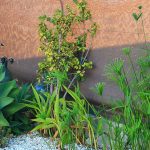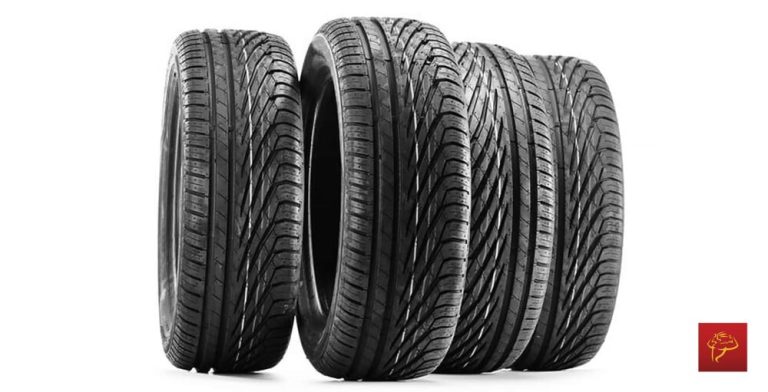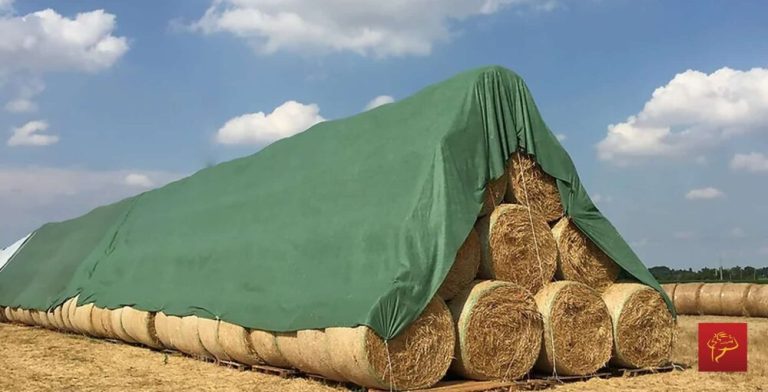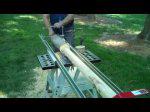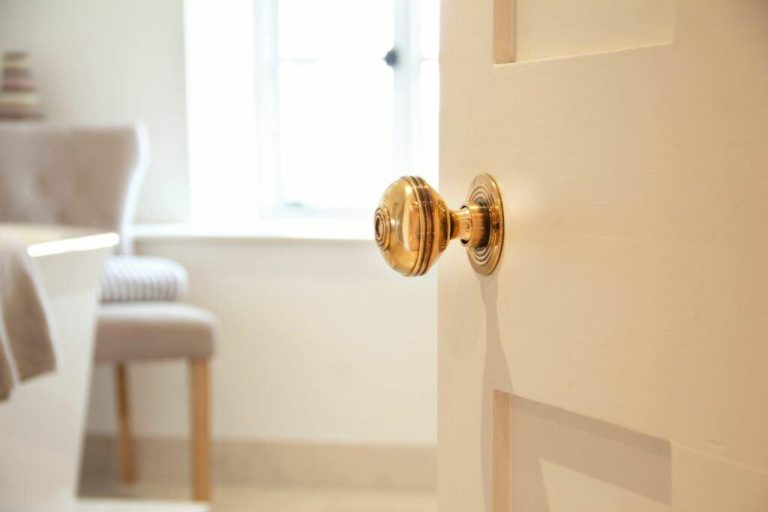10 Self-Seeding Plants for a Stunning Hands-Off Garden
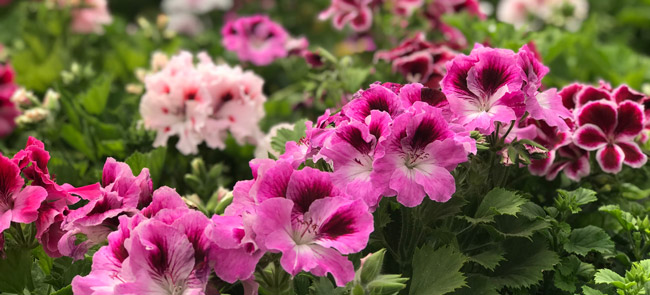
Maintaining a flower garden can be hard work, and not to mention expensive! Many plants out there need quite a bit of tender loving care. Plus, if you’re growing annuals, you have the added cost of buying new seeds every year.
This is where self-seeding plants come in! Filling your garden with them can make for a colourful, natural-looking landscape. Pollinators will love hanging out around your flowers, you won’t have to worry too much about constant care, and best of all – you won’t have to buy seeds all the time!
So, what are the best self-seeding flowers in the UK? Keep reading to find out!
If you:
- Are a fan of natural, colourful gardens;
- Want to fill your flower beds, but don’t want to spend too much on seeds;
- Are looking for a hands-off approach to garden design;
Then this post is just for you!
What are self-seeding plants?
Before we get into it, let’s explain what these types of plants are.
In a word, self-seeding plants are plants that sow themselves. When left to their own devices, they will flower, then turn to seed. The seeds either drop to the ground or get carried around by birds or the wind. Once in the ground, new plants start growing, and before you know it, your garden is full of colourful flowers.
Self-seeding plants are relatively low maintenance at the start, too. Most of the time, the seeds can grow wherever they happen to fall, regardless of the conditions.
The 10 best self-seeding flowers for your UK garden
Self-seeding plants have long been a staple in cottage gardens. Plus, they’re a fairly popular choice if you want a more relaxed gardening approach. There are tonnes of self-seeders out there to choose from. So, you’re sure to find the ones that suit your tastes and needs best.
If you want a relaxed method to soil maintenance, you might want to check out no-dig gardening. Not only are no-dig gardens low maintenance, they help promote soil health and structure.
Now, without further ado, here are 10 of the best self-seeding flowers in the UK!
1. Meadow cranesbill (Geranium pratense)
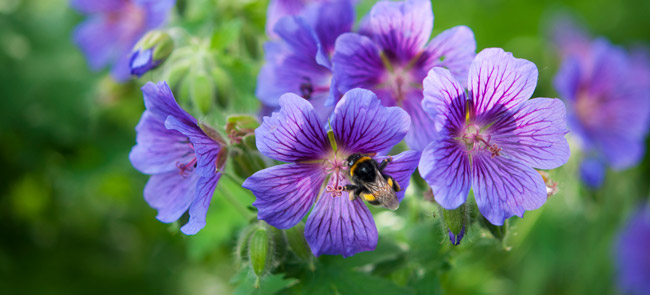
Image source: Shutterstock / olenaa
You’d have a hard time finding a cottage garden that doesn’t house the meadow cranesbill. This hardy perennial flowers from early to mid-summer in a vibrant purple, blue, pink, or white colour. It’s often found in borders and is easy to divide if it grows in larger clumps.
The meadow cranesbill is relatively easy to grow. It grows well in damp, moderately fertile soil, but won’t do well if it’s waterlogged. While it prefers growing in open spots in full sun or partial shade, it can do just fine in full shade, too.
What’s more, this self-seeding plant is fantastic for attracting pollinators, especially bees. So, if you’re looking to make a bee-friendly garden, meadow cranesbills are an excellent choice! This flower also attracts butterflies and other beneficial insects.
2. Forget-me-not (Myosotis sylvatica)
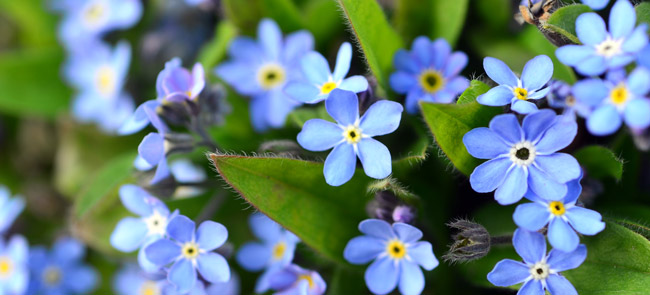
Image source: Shutterstock / Uellue
This self-seeding plant is known as a wood or garden forget-me-not, and most varieties are biennial. It produces delicate, light-blue flowers in mid-spring and summer that spread and cover the ground quickly.
Forget-me-nots are native to rocky and wooded areas. They will thrive in many different conditions but prefer partial shade and well-drained chalk, clay, or loam soil. These self-seeders spread rapidly, but if you want to keep them in check, they’re easy to pull out and transplant.
Forget-me-nots are a favourite among bumblebees, butterflies, and other pollinators, making them perfect for a wildlife garden.
3. Purple top (Verbena bonariensis)
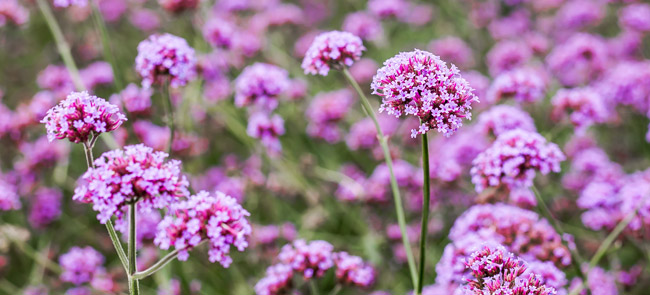
Image source: Shutterstock / Thunchit Wonghong
The purple top (or tall verbena) is another cottage garden favourite. This perennial spreads its seeds in autumn, producing beautiful flower clumps in summer until mid-autumn. It can quickly take over a large chunk of your garden if left unattended, but it won’t smother the plants around it.
The tall verbena is pretty easy to dig up if you want to keep its numbers in check. However, it doesn’t take too well to transplanting, so you might want to be more careful with what you remove.
Purple tops don’t usually need much care. They like full sun and moist, well-drained soil, usually chalk, clay, sand, or loam. If the colder seasons get a bit more extreme in your area, you might need to provide your tall verbena with some frost protection.
This self-seeding plant is a fantastic choice if you want to attract pollinators. Birds, bees, and especially butterflies – they all love purple tops!
4. Common poppy (Papaver rhoeas)
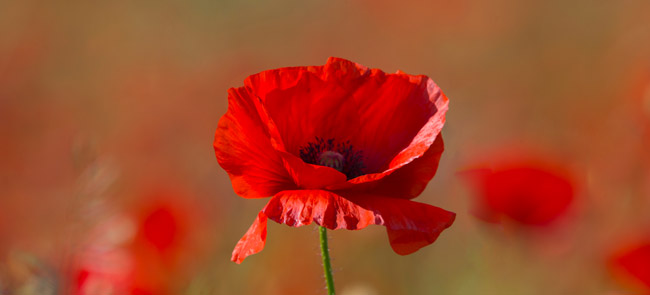
Image source: Shutterstock / sportoakimirka
The common poppy, along with its less common brethren, is a hardy self-seeding annual found in many places throughout the UK. They are a popular choice for wildlife or cottage gardens and are an excellent pollinator attractant. Bumblebees, in particular, are very fond of poppies, so they’re a great addition to your bee-friendly landscaping.
The common poppy grows well in full sun and well-drained fertile soil – typically chalk, loam, or sand. It can be sown in spring and produces its trademark red flower all summer long.
5. Common foxglove (Digitalis purpurea)
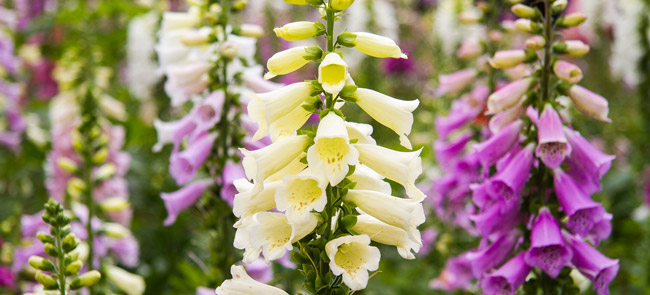
Image source: Shutterstock / Thi Dolphin
The common foxglove, also known as “lady’s glove” and the not-at-all-gruesome “bloody bells”, is a hardy perennial that can thrive in various conditions. It prefers moist, well-drained, fertile soil, but can grow well in any light, from full sun to full shade. Foxgloves are not too fond of extremely wet or dry conditions, though, so make sure you water them moderately.
This self-seeding plant can be sown in mid to late summer and flower in late spring to mid-summer, usually in a vibrant purple or pink. Foxgloves are known to attract bees and butterflies, and caterpillars love munching on them.
Foxgloves can be toxic to humans, cats, and dogs. When handling this plant, we recommend that you wear gloves and thoroughly wash your hands after. If you have pets, make sure they can’t reach the plant or avoid sowing it altogether.
6. Common columbine (Aquilegia vulgaris)
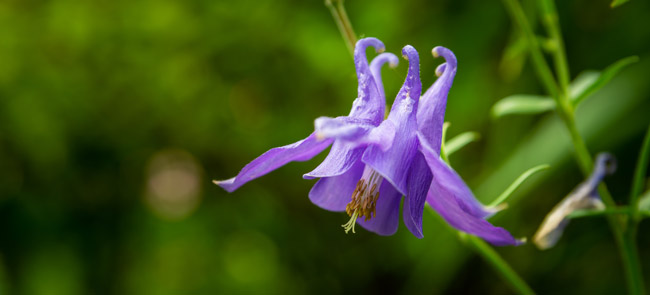
Image source: Shutterstock / Dariusz Banaszuk
Another stunning self-seeding plant, the common columbine (or American bluebell) is a great choice if you love surprises. That’s because you never know what you’re going to get! Usually, the colour of the new plants is entirely different from the one of the parent. So, if you want an ever-changing, colourful garden, the common columbine might just be for you.
This perennial self-seeder flowers from spring until early summer, often in a beautiful purple or blue shade. Columbines prefer shadier spots but will grow well in full sun, too. They like fertile, well-drained soil – mostly sand and loam.
The entire columbine plant is poisonous when ingested, so take care to prevent your pets from accessing it. Its sap can also be irritating to the skin, so we recommend wearing gloves when handling it.
7. Common marigold (Calendula officinalis)
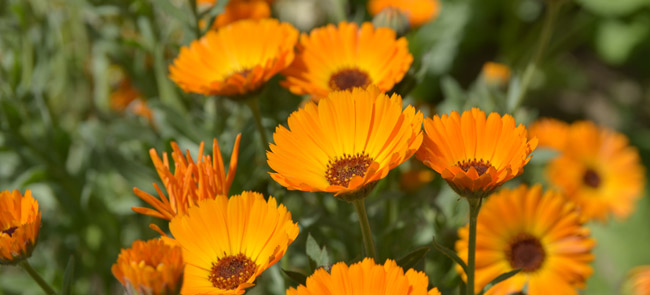
Image source: Shutterstock / Miguel M.P
The common marigold (also known as pot marigold) is typically grown as an annual. When allowed to self-seed, it can quickly provide you with a vibrant display of yellow and orange. Sown in autumn or spring, marigolds flower from May until around September. They are also a favourite of butterflies everywhere!
This self-seeding plant can grow in full sun or partial shade and prefers light, well-drained soil like chalk, loam, or sand. If you want to prolong the flowering period and promote bushier growth, we recommend deadheading it regularly and removing any terminal shoots.
Did you know that calendula flowers are edible? You can find them in soups, salads, or a refreshing summer drink! They are often used as a substitute for saffron, too.
8. Borage (Borago officinalis)
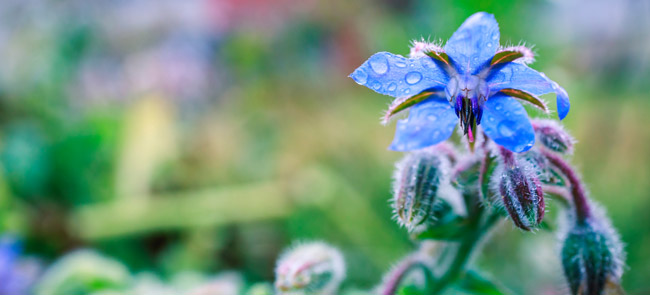
Image source: Shutterstock / Salah Ait Mokhtar
Among the more unique-looking self-seeding plants, borage is a half-hardy annual that can spread like wildfire! It’s a fantastic choice for a cottage garden and is known to attract various pollinators, such as bees and other beneficial insects.
Borage likes growing in full sun and well-drained soil, either chalk, clay, loam, or sand. You can sow it in spring and watch it produce star-shaped flowers in a vibrant blue. This self-seeder spreads very quickly, so you’ll have to dig up any unwanted growth to keep it in check. However, borage is not fond of transplanting, so take care not to dig up a plant you want to keep.
Just like the pot marigold, borage petals are edible and have long been used for their medicinal value. You can often find it in summer drinks or various dishes, where it adds a pop of colour and a fresh taste, similar to cucumber.
Borage can be toxic to cats and dogs, so take extra care if you have pets that like to roam around your garden.
9. Violet (Viola tricolor)
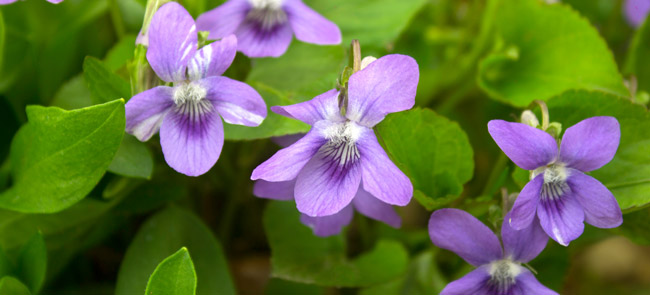
Image source: Shutterstock / Sunbunny Studio
If you want a self-seeder with a colourful yet delicate look, violets are a wonderful option. The Viola tricolour variety is among the more popular ones, producing soft purple, white and yellow flowers from spring through early autumn.
The violet prefers well-drained and fertile soil, such as clay, loam, or sand. It likes growing in full sun or partial shade but can do just fine in full shade, too. Just make sure to avoid waterlogged soil.
This violet variety is another self-seeding plant with edible flowers (in moderation). You should avoid the roots and seeds, however, as they can be toxic.
10. Cosmos (Cosmos bipinnatus)
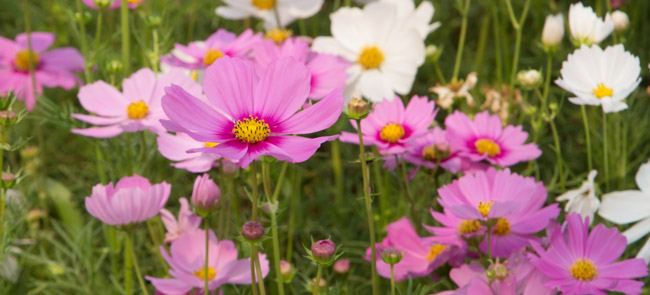
Image source: Shutterstock / Kwanbenz
And to finish off our list of the best self-seeding flowers in the UK, we have the cosmos (or cosmea). This annual grows well in many different conditions and doesn’t require extensive care to thrive. The cosmos flower prefers full sun and moderately fertile, well-drained soil, often chalk, loam, or sand.
This self-seeder is a wonderful choice if you want to attract pollinators to your garden, bees in particular. Plus, it spreads its seeds with ease, so if you’re working with a tricky landscape, give it a go!
Cosmea flowers in summer and fall in a soft pink or white colour. If you want to prolong the flowering period, deadhead it regularly.
Bonus: Self-seeding vegetables
If you’re a vegetable gardening enthusiast, we’ve got something for you, too! There are various veggie plants that reseed themselves and can save you both time and money. Plus, you get some extra tasty crops!
Some vegetables will self-seed when left in the soil. These include:
- Alliums (onions, leeks, etc.)
- Potatoes
- Radishes
Other veggies will burst and go to seed if left on the plant after maturing. Some of these are:
- Cucumbers
- Courgettes
- Beans
There are a lot more self-seeding plants you can add to your vegetable garden, so you’re sure to find what you need!
Need a hand in your garden?
If you want a stunning, colourful garden but don’t have the time to maintain it, give us a call! At Fantastic Services, we work with reliable garden maintenance experts that can turn your green space from a barren lawn into something out of a fairytale!
Whether you need regular lawn mowing, flower bed care, or hedge trimming, the specialists can do it all. Find out more about how we can help your garden thrive today!
Need a Gardener?
Find a professional to keep your plants happy and healthy!

Takeaways
- Self-seeding plants don’t need to be sown manually – they spread their seeds and plant themselves wherever they land.
- There is a wide range of self-seeding flowers in the UK, each with its own unique look and care requirements.
- Most self-seeders don’t need special conditions to start growing; all they need is the soil they land on.
- Some of these plants, such as marigolds, borage, and violets, are edible and can be found in various dishes.
- Foxgloves, borage, and columbines can be toxic to cats and dogs. The foxglove and columbine can also be irritating to humans, so handling them with care is recommended.
- Most self-seeding flowers are great at attracting bees, butterflies, and other pollinators.
- There are many self-seeding vegetables out there, too. So, if you want to maintain an inexpensive veggie garden, give them a try.
Now that you know all about self-seeders, why not go one step further? Check out our post on how to create a cottage garden next!
***
We hope you found our list of self-seeding plants helpful and informative. Do you have a favourite? Let us know in the comments!
Image source: Shutterstock / Nice_she
